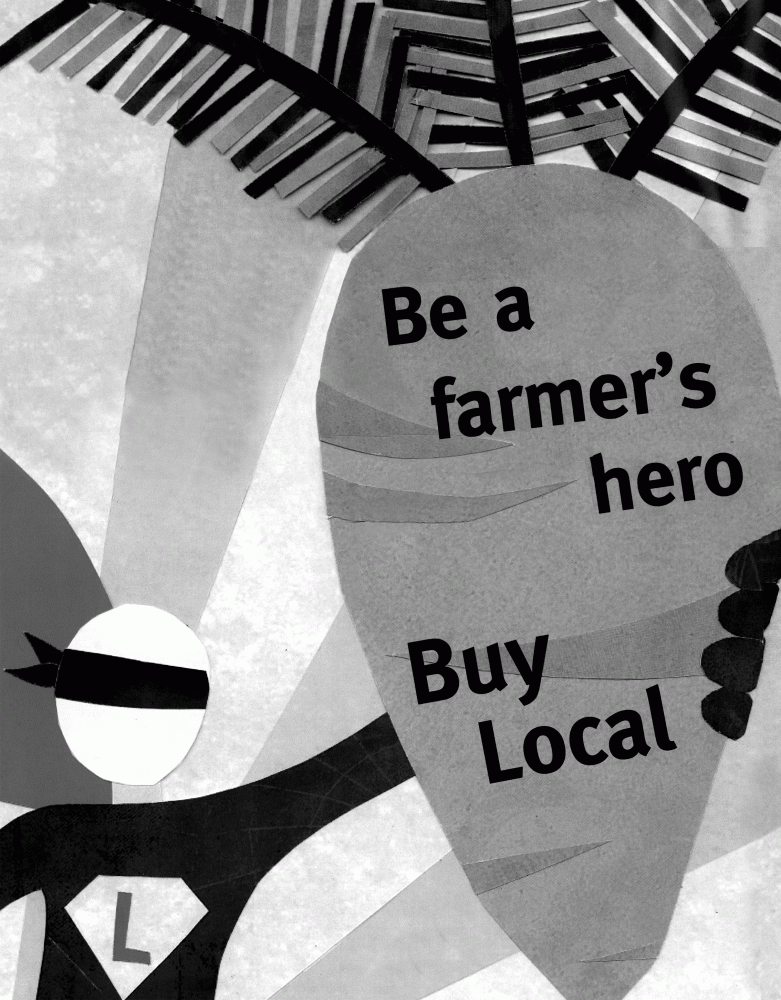Swapping Swipes for Local Eats
Overworked and broke, students don’t care where their food comes from—as long as it’s cheap, it works. However, the methods used to grow, harvest, transport and sell food products have come under popular scrutiny in the past few years, and college students would be wise to put down their packaged protein bars and tune in to the conversation on local eating.
In 2005, Vancouver couple Alisa Smith and J.B. MacKinnon published The 100-Mile Diet, a memoir sharing the experience of relying exclusively on produce grown within 100 miles of their home. Two years later, Barbara Kingsolver’s Animal, Vegetable, Miracle, an account of her family’s experience buying food grown in the area around their Virginia home, made “locavore” a household term. Although shunning national chain grocery stores in favor of farmers markets is now common, local eating is still stigmatized. Food companies and skeptics spin reliance on local agriculture as simultaneously elitist and backwards-thinking—branding the movement as a fringe attempt to undermine agricultural progress and send America back to the dark ages.
Dependence on large-scale supermarkets and out-of-season food shipped from halfway around the world is a troubling trend. Ignorant of or apathetic toward seasonal change, many modern consumers walk into the grocery store in December and expect to see Brazilian tomatoes nestled alongside South African apples and Doritos from who-knows-where.
Eating locally is possible even on a college budget and is often cheaper than relying on university food. The US Department of Agriculture estimates the grocery costs of a budget-constrained 19-50 year old male to be $52 a week. Spent wisely, $50 a week buys more than enough produce from the farmer’s market—for that much, one could purchase many carrots, a pound of apples, a bunch of kale, some beets, a couple of onions, half a pound of potatoes and a few cloves of garlic. Students can purchase essential baking staples or dried goods, like rice and beans, from bulk bins at a local health food stores or co-ops.
The basic American University meal plan for 2011-2012 first and second year on-campus students adds up to $2,270 per semester. The plan includes $400 of Dining Dollars and 150 meal swipes, or nine meals per week—nine swipes, each worth roughly $12.50, is $112.20 per week, not including any combination of the additional 12 breakfasts, lunches or dinners students must buy on their own. Even if a student chooses to rely on the infamous Ramen Noodle diet to fill out the remaining meals, on-campus dining is twice as expensive as the low-cost grocery budget allotted by the USDA.
DC boasts 11 producer-only farmers markets spring through fall. At least two, Dupont Circle and Silver Spring, stay open year-round. AU also hosts a small “farmers market” on the quad with produce from as far away as Pennsylvania. Although city markets dwarf school-sponsored vendors, the on-campus market represents a step toward sustainable eating. On campus students held hostage by a mandatory meal plan are able to buy local fruits and vegetables to snack on and avoid filling the gaps between meal blocks with less advantageous options. Greater reliance on local produce does not restrict food choices or take the fun out of cuisine, and regional-focused diets hardly lack variety. Local apples and carrots serve as quick snacks in the fall, and summer berries can easily be frozen and saved for sweet treats in the fruit-scarce winter months. Undergraduates living off campus and not bound to a meal plan possess substantially more freedom in their food choices. With access to a standard kitchen and full-sized fridge, an off-campus student can thrive on a diet of organically grown—and creatively prepared—local produce.
Instead of supporting an unsustainable system in which the average meal travels over 1,500 miles from farm to factory to plate, students can elect to back a regionally minded system of producer-consumer interaction. By supporting local agriculture, students not only provide financial support for farmers but environmental support for the planet and nutritional support for themselves. Buying local produce empowers them to fight for a sustainable future through an act as simple as buying a bunch of carrots from a local farmer.
Some might find the jump from TDR to berries and kale a bit jarring. But, especially over the long term, a habitual diet of Ramen and Tavern fries at midnight doesn’t do the body, the wallet, or the planet any favors.
Illustration by Becca Barton







